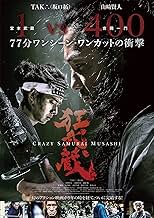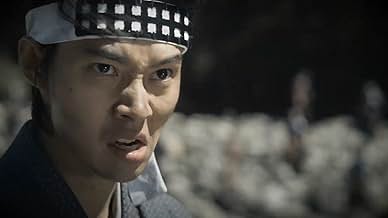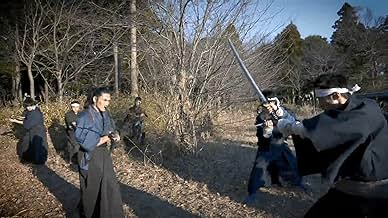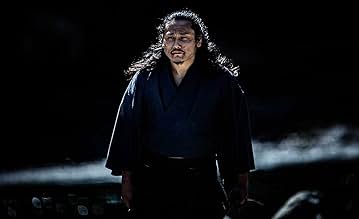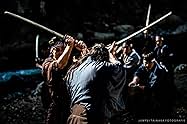Kyô Samurai Musashi
- 2020
- 1h 31m
IMDb RATING
4.6/10
1.1K
YOUR RATING
The most famous battle of the swordsman Miyamoto Musashi. Miyamoto fights against 588 enemies, one after the other. There is no room for error, no room for trivial, outdated, or unconvincing... Read allThe most famous battle of the swordsman Miyamoto Musashi. Miyamoto fights against 588 enemies, one after the other. There is no room for error, no room for trivial, outdated, or unconvincing movements.The most famous battle of the swordsman Miyamoto Musashi. Miyamoto fights against 588 enemies, one after the other. There is no room for error, no room for trivial, outdated, or unconvincing movements.
- Director
- Writer
- All cast & crew
- Production, box office & more at IMDbPro
Featured reviews
Very cool to pull a "one shot" off, but man did it ever trade that for the things I expect in a hardcore samurai movie. Not even ONE decapitation. So sad...
A good samurai movie. It does contain the longest fighting sequence, in a single shot! Fighting does feel repetitive, but you can't compare it to anything else, cuz no one else did the same thing.
Real dedication showcased. I wish they had longer first and last scenes, and a shorter fighting sequence in between.
There is very little effort made in setting up how or why the fight happened and so as a story the plot (i.e. the central conflict) is lacking. Man v. man, yes, but without setting it up there's no real story here. I'm happy I bought it and watched it as encouraging innovation in chambara or jidai geki (definitely the former). As entertainment it lacks because it goes on long enough to spot some glaring issues easily ignored in shorter scenes. 1) the shortest distance between two points is a line. From the middle stance, one is always threatening the throat strike as the most efficient killing blow but he never does it. I get it for safety's sake but after so much coverage it becomes more obvious. 2) no one who charges from the high stance has any actual intent to connect the downward swing. You can tell because he's easily able to connect a slice to the midriff (should be a "men" attack probably) before the downswing ever happens. He does this without needing to step forward or do anything to throw off their timing. 3) no coordination from the attackers. The very few times they attack simultaneously, it's high so both blows can be blocked with the same block. The only way they could have won would be such simultaneous attacks but from different angles & directions. I take issue with those who say no blood gets on his blade because it's manifestly inaccurate. I agree with those who say that the few extras in the exact same outfits & hairpieces is something easily perceived after so many minutes of coverage.
Things that still impress me 1) the actor's physical stamina. Even if the "sword" is light wood, it has to be heavy enough to receive a lot of blows without visually bending or distorting. The actor holds that thing up an impressive length of time. We used to do an exercise in my Okinawan style where we would hold our arms parallel to the ground for as long as we could and it was never long. We just couldn't do it. 2) the preparation of the character for the battle in advance. He knows he'll need extra swords & water, so he set them up in advance. I'd like to circle back to the actor's stamina here because until close to the end he drinks very little of the water, preferring to rinse his mouth & his "blade." He's obviously sweating for real & doing a lot off physical activity so again, impressive. 3) the fight scene at the end.
The last bit of criticism I have wasn't mentioned yet, and that is not letting us see the last opponent defeated. After making us sit through all that attacking without even giving us the emotional satisfaction of completion felt like a deliberate waste of our time. If they were going to cut away, why not edit? Why not show the ending after spending so much time setting it up.
Things that still impress me 1) the actor's physical stamina. Even if the "sword" is light wood, it has to be heavy enough to receive a lot of blows without visually bending or distorting. The actor holds that thing up an impressive length of time. We used to do an exercise in my Okinawan style where we would hold our arms parallel to the ground for as long as we could and it was never long. We just couldn't do it. 2) the preparation of the character for the battle in advance. He knows he'll need extra swords & water, so he set them up in advance. I'd like to circle back to the actor's stamina here because until close to the end he drinks very little of the water, preferring to rinse his mouth & his "blade." He's obviously sweating for real & doing a lot off physical activity so again, impressive. 3) the fight scene at the end.
The last bit of criticism I have wasn't mentioned yet, and that is not letting us see the last opponent defeated. After making us sit through all that attacking without even giving us the emotional satisfaction of completion felt like a deliberate waste of our time. If they were going to cut away, why not edit? Why not show the ending after spending so much time setting it up.
Crazy Samurai: 400 vs. 1, also known as Crazy Samurai Musashi, is based upon writer, swordsman, strategist, ronin and philosopher Musashi Miyamoto who has inspired numerous legends. This low-budget movie shows how the titular hero confronts four hundred swordsmen when arriving to duel the disgraced Yoshioka dojo.
This movie can be separated into three scenes. The first scene is filled with atmosphere, context and tension as the members of the disgraced dojo expect the swordsman to arrive. They are planning on ambushing him but are obviously underestimating their enemy's wit.
The second scene has been filmed in one single take and lasts for seventy-seven minutes. Musashi Miyamoto confronts his enemies. They fight in a forest, on a field, in a house, in a court and later on in a small village. There are a few elements that offer some short breaks from the fight sequences such as the protagonist's brief monologues, the argument between two samurai and a peasant girl who betrays the hero.
The final scene takes place several years after the events portrayed before. It shows us what Musashi Miyamoto has become and what his foes are willing to do to murder him for once and for all.
The movie title already indicates exactly what you get here. This film is filled with fight scenes from start to finish. The stamina of lead actor Sakaguchi Taku is quite remarkable. The beautiful locations bring to life Japan in the early seventeenth century. Some of the fight scenes end up being a little bit repetitive. The visual effects look quite cheap but one gets used to them. The ending of the second scene felt a little bit unfinished in my opinion but didn't have an overall negative impact.
To keep it short, this movie is only interesting for martial arts enthusiasts and people who are interested in Japanese culture, history and legends. The movie has an unusual approach which makes it interesting to watch despite some repetition here and there. You should not expect witty dialogues, profound plot and unexpected twists here. Genre fans will get what they want and everyone else should simply ignore this film.
This movie can be separated into three scenes. The first scene is filled with atmosphere, context and tension as the members of the disgraced dojo expect the swordsman to arrive. They are planning on ambushing him but are obviously underestimating their enemy's wit.
The second scene has been filmed in one single take and lasts for seventy-seven minutes. Musashi Miyamoto confronts his enemies. They fight in a forest, on a field, in a house, in a court and later on in a small village. There are a few elements that offer some short breaks from the fight sequences such as the protagonist's brief monologues, the argument between two samurai and a peasant girl who betrays the hero.
The final scene takes place several years after the events portrayed before. It shows us what Musashi Miyamoto has become and what his foes are willing to do to murder him for once and for all.
The movie title already indicates exactly what you get here. This film is filled with fight scenes from start to finish. The stamina of lead actor Sakaguchi Taku is quite remarkable. The beautiful locations bring to life Japan in the early seventeenth century. Some of the fight scenes end up being a little bit repetitive. The visual effects look quite cheap but one gets used to them. The ending of the second scene felt a little bit unfinished in my opinion but didn't have an overall negative impact.
To keep it short, this movie is only interesting for martial arts enthusiasts and people who are interested in Japanese culture, history and legends. The movie has an unusual approach which makes it interesting to watch despite some repetition here and there. You should not expect witty dialogues, profound plot and unexpected twists here. Genre fans will get what they want and everyone else should simply ignore this film.
Totally unrealistic.
95% of the actors who supposedly get killed either fall behind a tree/building, get concealed by a couple of other actors, or stumble out of the camera field of view. Only to reappear minutes later.
When the camera eventually pans around only 2-3 bodies are there instead of a pile of around 60+ corpses.
You end up watching the same repeated sequence over and over... one person at a time attacks, gets pommelled on the head, crawls off screen, and reappears a few minutes later.
I guess due to the lack of actors involved this was necessary, but this is child's playground fare in its execution. An army being represented by a dozen or so people constantly running around the cameraman is beyond acceptable.
95% of the actors who supposedly get killed either fall behind a tree/building, get concealed by a couple of other actors, or stumble out of the camera field of view. Only to reappear minutes later.
When the camera eventually pans around only 2-3 bodies are there instead of a pile of around 60+ corpses.
You end up watching the same repeated sequence over and over... one person at a time attacks, gets pommelled on the head, crawls off screen, and reappears a few minutes later.
I guess due to the lack of actors involved this was necessary, but this is child's playground fare in its execution. An army being represented by a dozen or so people constantly running around the cameraman is beyond acceptable.
Did you know
- TriviaActor Tak Sakaguchi broke one finger, one rib and four of his teeth during the 77 minute battle sequence.
- GoofsMusahashi couldn't have known where to immediately find something to drink for each of his several breaks in a deserted village on the other clan's turf.
- How long is Crazy Samurai Musashi?Powered by Alexa
Details
- Release date
- Country of origin
- Official site
- Language
- Also known as
- Crazy Samurai Musashi
- Production companies
- See more company credits at IMDbPro
- Runtime1 hour 31 minutes
- Color
- Aspect ratio
- 1.78 : 1
Contribute to this page
Suggest an edit or add missing content


